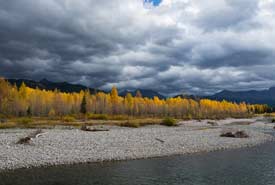Elk Valley Heritage Conservation Area

The Wigwam River on Mt. Broadwood, in the Elk Valley Heritage Conservation Area. (Photo by Lyle Grisdale)
The Elk Valley is a critically important wildlife corridor that accommodates the north-south movement of wide-ranging carnivores. Animals such as grizzly bear, wolf, wolverine and lynx pass through here. The area has undergone some development for resource extraction over the past 50 years (logging, linear corridor development and road building). However, it remains remarkably intact in terms of biological integrity. The existence of healthy populations of carnivores throughout the North American Rocky Mountains depends on the continued existence of populations in the Elk Valley.
The Elk Valley Heritage Conservation Area encompasses 13,100 hectares (32,500 acres) along the Elk River near Fernie, British Columbia. These lands include low-lying wetlands, mixed grassland-forest and steep, forested uplands. These lands are high-value linkage corridors for large carnivores moving north-south through the valley. To effectively conserve wide-ranging carnivore populations in the Canadian Rocky Mountain Ecoregion, the Nature Conservancy of Canada (NCC) decided to prioritize the conservation of three very high-value linkage corridors in the Elk Valley.
The Elk Valley Heritage Conservation Area includes NCC-owned lands, in addition to conservation agreements on lands owned by Tembec. Additionally, the Elk Valley Heritage Conservation Area is connected to provincial lands by another NCC project within the Elk Valley, the Morrissey Meadows Conservation Area. This connectivity offers significant conservation benefits to the surrounding environment, as it enhances habitat security for wide-ranging mammals in the area.
Mount Broadwood

A hiker on Mt. Broadwood (Photo by NCC)
At the heart of the conservation assembly is Mount Broadwood. This 8,950-hectare (21,000-acre) mountain property was donated to NCC by Shell Canada in 1992.
Mount Broadwood supports the full suite of large animals that roam throughout this region. The conservation area protects outstanding wintering grounds for bighorn sheep, elk and mule deer. Other resident wildlife include moose, elk, grizzly and black bear, grey wolf, cougar, wolverine, badger, fisher and Rocky Mountain tailed frog.
The Wigwam River flows through the property. It supports some of the largest cutthroat trout in southeastern British Columbia. This river is the single most important bull trout spawning system in the Kootenay Region. Sockeye (kokanee) salmon were introduced in the early 1970s. The Wigwam River and Lodgepole Creek are open to catch-and-release fly fishing.




